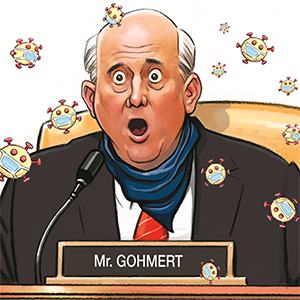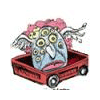Ask The Vet: Canine Carsickness Common But Treatable
Q: We recently adopted Rufus, a young adult dog who becomes anxious every time he's in the car. He pants, whines, drools, licks his lips and sometimes even throws up. What can we do about this?
A: The most effective way to help Rufus feel calm in the car is behavior modification. Through a series of small steps, you'll teach him that car rides are nothing to fear but, instead, can be a source of fun.
Start by feeding him his meals in the car with the engine off. If he won't enter, put his food bowl on the ground next to the car. After a week of this, he should be willing to eat in the car.
When he's eaten enough times in the car to be relaxed there, he'll be ready for the next steps. Be sure to take them when Rufus has an empty stomach, so he doesn't get carsick.
Invite him into the car, and start the engine. If you're in the garage, back out and idle in the driveway for a few minutes. Then return to the garage, and turn off the car.
Praise Rufus when he's calm in the car but not when he gets out.
Repeat this step as many days or weeks as necessary until Rufus is relaxed and doesn't pant, drool or whine.
The next step is to drive around the block once and return home. Be sure Rufus has plenty of fresh air and can see out. Again, repeat this step as many times as necessary until Rufus is relaxed.
Next, drive a few minutes to a park or a friend's home so Rufus learns to associate the car with fun excursions. Repeat these short, enjoyable trips often before gradually lengthening his car rides.
If he ever seems anxious, return to the previous step until he's relaxed enough to proceed. Plan to desensitize Rufus to car rides over a period of weeks to months.
To help him feel comfortable, outfit him with an Adaptil collar, or spray Adaptil in the car and on a neck bandana 10 minutes before his car time. Adaptil contains the dog appeasing pheromone that mother dogs produce while their puppies nurse. It helps even adult dogs feel calm, relaxed and secure.
Alternatively, apply a teaspoon of lavender oil to each of two cloths, and drape them over the car seats 30 minutes before each car ride, keeping the windows closed to concentrate the scent.
If these recommendations don't solve the problem, talk with your veterinarian about Cerenia, a prescription medication for motion sickness.
Q: My new kitten was sneezing and had red, weepy eyes when I adopted him from a friend. Soon after, my adult cat started sneezing. I took them both to the veterinarian, who diagnosed an upper respiratory infection, or URI. What causes URI in cats?
A: As you've learned, feline upper respiratory infections are extremely contagious. The "upper" in the name means this is a head cold, not a lung infection.
URIs can range from mild to severe, with kittens most profoundly affected. Clinical signs include sneezing, nasal and ocular discharge, conjunctivitis, oral ulcers, fever, lethargy and loss of appetite.
In about 90% of cases, the cause is feline herpesvirus (also called rhinotracheitis virus) and/or calicivirus. The virus may weaken the respiratory tract, allowing bacteria such as Chlamydophila (also called Chlamydia), Mycoplasma or Bordetella to proliferate.
Treatment depends on severity and whether a bacterial infection accompanies the viral infection. You should make sure your kitty keeps eating and drinking. Warm his food, if necessary, to enhance its aroma.
Use a soft cloth dampened with warm water to clean his face. A vaporizer may help thin his nasal mucus and make it easier for him to breathe.
In most herpes-infected cats, the virus remains in the body forever and resurfaces if stress suppresses the immune system. However, these URI recurrences are usually mild and resolve on their own.
========
Lee Pickett, VMD, practices companion animal medicine in North Carolina. Contact her at https://askthevet.pet.
Copyright 2025 Creators Syndicate Inc.








Comments